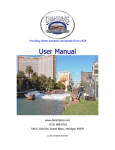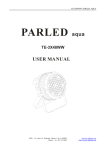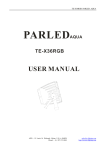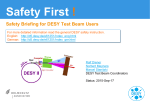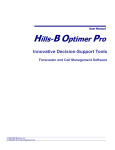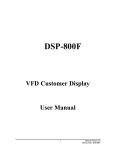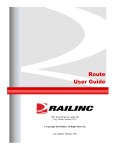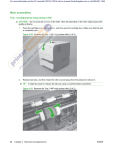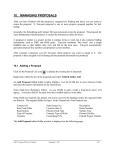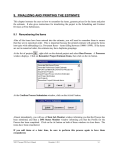Download RIMS Guide-v04
Transcript
1 Introduction Welcome to the Roadway Inventory Management System (RIMS) Tutorial. This guide is a companion to the RIMS Business Guide and the RIMS User Guide. This tutorial contains specific use cases and detailed examples that will introduce you to the tasks, screens, and data inputs necessary to successfully use RIMS. This guide contains four sections. These are: 1. Introduction… 2. Types of Road Changes… 3. Examples… 4. Appendix… 2 The Road Inventory W hat is the Road Inventory? The road inventory contains important information about the public roads in the state of Virginia. It includes data such as the road name, route number, length, and location. It also includes physical characteristics such as the number of lanes and pavement type. Road ownership and maintenance responsibility are also stored in the inventory. W hat is the Road Inventory used for? The road inventory is crucial for project development, maintenance, and operations tasks. Some important tasks that might require the road inventory include highway safety analysis, traffic monitoring, and pavement management. External reporting requirements, such as reporting to FHWA and the HPMS, also require the road inventory data. Fulfilling the road inventory requirements are crucial to securing Federal funding for VDOT. W hat data are stored in the Road Inventory? The amount of data stored in the inventory is dependent on the agency that maintains the road. Only public roads that are maintained by VDOT are required to have detailed inventory data. The data include mapping data, physical characteristics, and administrative characteristics, such as ownership. The road inventory also contains a mapping component, which links the inventory data to location data in the VDOT GIS map. The geospatial road inventory incorporates some road centerlines provided by the Virginia Geographic Information Network (VGIN). The map data are provided to GIS Integrator 2.0 to link relate the road inventory data to a geographic location and route number. How does RIM S relate to the Road Inventory? In order to ensure the accuracy of the road network, VDOT continues to update the road inventory when new roads are constructed, changes are made to current roads, and roads are removed. These functions require the use of RIMS. For a complete list of data included in the road inventory, refer to A pp endix A . 3 Database for Administering Changes to the Highway System (DACHS) W hat is DACHS? The Database for Administering Changes to the Highway System (DACHS) is used to manage the legal roadway acceptance process. W hat projects are initiated in DACHS? DACHS is used to input new roadways that require official acceptance or approval. Approval can be required by any one of three entities: • Local Governing Bodies (LGBs); • the Commonwealth Transportation Board (CTB); • and/or the VODT Commissioner (or his designee). The primary function of DACHS is to assist staff with completing the necessary steps and forms to legally accept a road. The projects that are typically entered through DACHS include: • Additions; • Abandonments; • Discontinuances; • Transfers; • Route renumbering, and; • Annexation and de-annexation W hat inform ation does DACHS require? DACHS requires the user to enter basic inventory data on the roadway, such as the project name, location, project type, street name and description, mileage, number of through lanes, and median type. W hat is the final output from DACHS? When the required information has been entered, and the project has been reviewed and authorized, DACHS creates an Inventory Change Request (ICR). The ICR is then sent to the Roadway Inventory Management System (RIMS). For more information on the road changes that are required to be initiated in DACHS, including information on the route designation and the necessary source of approval, refer to A pp endix B. For a complete list of the required data and valid inputs, refer to Sec tion 2.1 or A pp endix A . 4 5 Roadway Inventory Management System (RIMS) W hat is RIM S? RIMS is used to manage road inventory data and to store the Official Roadway Data Inventory for Virginia. RIMS assists with managing the road inventory data, by making changes and adding data to the existing road network. The major functions of RIMS are to: Maintain information in the Road Inventory including physical, administrative, and operational characteristics; • Maintain the Route Inventory required for linear referencing; • Assist in the process for Inventory Changes; • Integrate with GIS Integrator 2.0 to maintain map data; • and create Reports. How do you open a project in RIM S? Projects are opened in RIMS using the Inventory Change Request (ICR). Note: the ICR is typically initiated in DACHS. Projects that do not require approval and are not initiated in DACHS can be created directly in RIMS with a “miscellaneous ICR”. • W hat data does RIM S require? In addition to the basic inventory data provided in the ICR, RIMS requires detailed roadway data. This includes _____. In addition to location data, RIMS also requires a visual representation of the new roadway, sometimes called the “sketch”. If no sketch is available, the user can create one using the Redline tool. This information provides the basis for the road centerline. W hat happens when an ICR is subm itted for CET/LRS processing? When the appropriate data have been input in RIMS (complete with a drawing, road location, and route number) the data is sent to the Centerline Editors and RIMU Staff. The centerline editors add and/or modify route centerlines using the Centerline Editing Toolset (CET). When the road has been successfully added to the RCL with accurate mileage and location, the RIMU editors review the map. These steps ensure that the roadway has been accurately located on the map, as the route centerline will be linked to the corresponding inventory data. W hat other tasks can RIM S perform ? In addition to editing the road inventory, RIMS can be used to reserve route numbers. This function is particularly important for developers creating subdivisions and other large projects that will generate a number of new roadways. In this case, multiple route numbers can be reserved at one time to ensure continuity. RIMS can also be used to query the road inventory. Create a map output… For more information on: • • • • • The Redline tool, refer to Section 2.4. Submitting a project to TMPD, refer to Section 4.1. Reviewing and completing a project in RIMS, refer to Section 4.2. Reserving route numbers in RIMS, refer to Section 2.3. Querying data in RIMS, refer to Section 3.5. 6 DACHS and RIMS in Action To update the inventory using RIMS and DACHS, the following workflow shows the basic steps that should be taken, the staff responsible for completing each tasks, and the software that will be utilized. Section 2 will elaborate on this workflow and specify the different processes for each type of edit to the road inventory. 7 Section II: Types of Road Changes This section provides basic example steps for each type of adjustment that can be made in RIMS. Each description provides additional resources for a more detailed understanding of the process. The two companion guides referenced in this section are the RIMS Business Guide and the RIMS User Manual. The Business Guide provides an overview and processes for inventory updating, and general step-by-step instructions for performing basic tasks. The User Manual provides more detailed instructions for using each screen of the RIMS application. 8 9 The following shows each of the road change types that can be completed in RIMS. This diagram will be grouped by type (i.e. the categories used in the draft outline). Addition (ADTN) Labeled as “Addition” in DACHS. An Addition (ADTN) is used for a new route (using a new route number) or an extension to the end of a route (continuing the same route number). Realignment: Add (RALN) Labeled as an “Addition” in DACHS. Abandonment (ABAN) Labeled as an “Abandonment” in DACHS. A Realignment: Add (RALN) is used for an extension to the beginning or middle of an existing route. A realignment uses the same route number but changes the length and/or the starting point of the route. An Abandonment (ABAN) is used if the roadway is: • Not being used and/or maintained, • The abandoned section is not being replaced by a new road (called an isolated abandonment), and • The road being abandoned still exists. 10 Discontinuance (DICO) Labeled as a “Discontinuance” in DACHS. Delete (DELE) Labeled as an “Abandon” in DACHS. A Discontinuance (DICO) is used for an isolated discontinuance (the abandoned section is not being replaced by a new road). This means that the route number will be removed. This typically occurs when VDOT stops maintaining a roadway. A Delete (DELE) is used if the roadway is: Renumber (RENU) • Not being used and/or maintained, • The abandoned section is not being replaced by a new road (called an isolated abandonment), and • The road has been physically removed (for example, replaced by buildings). Labeled as a “Transfer” in DACHS. A Renumber (RENU) is used for when a route is given a new route number. This can occur when a road changes classification or is transferred across highways systems. Note: When a renumber occurs, the existing route is always removed from the centerline. Renumber (RENU) Labeled as a “Renumber” in DACHS. A Renumber (RENU) is used for when a route is given a new route number. This can occur when a road changes classification or is transferred across highways systems. Note: When a renumber occurs, the existing route is always removed from the centerline. 11 Remove (REMV) A Remove (REMV) is used if overlapping routes exist on a centerline and one must be removed. Promote to Master (PROM) A Promote to Master (PROM) I used to make an overlapping route the master route on a road centerline. It can also be used to place a new route on an existing centerline and at the same time, make the new route the master route. Split (SPLT) Labeled as a “Data Correction” in DACHS. A Split (SPLT) is used if a new intersection is added to an existing road section. nt. Realignment: Add (RLAN) Labeled as an “Addition” in DACHS. A Realignment: Add (RLAN) is used for an extension to the beginning or middle of an existing route on a new alignment. 12 Realignment: Abandonment (RABA) Labeled as an “Abandon” in DACHS. Realignment: Discontinuance (RDIC) Labeled as a “Discontinuance” in DACHS. Realignment: Delete (RDEL) Labeled as an “Abandon” in DACHS. Realignment: Remove (RREM) A Realignment: Remove (RREM) is used to remove an existing overlapping route from a centerline as part of a realignment. A Realignment: Abandonment (RABA) is used when an abandonment is happening at the same time as a realignment and the road being abandoned is still physically intact. This means that a route is being rerouted, although the initial route still exists. A Realignment: Discontinuance (RDIC) is used when a realignment is taking place at the same time as a discontinuance. A Realignment: Delete (RDEL) is used when a abandonment is happening at the same tie as a realignment and the road has been physically removed. This means that the route is being re-routed and the initial route has been removed. 13 Assign Route (ASSN) An Assign Route (ASSN) is used to assign a new overlap route to an existing centerline. (used to describe the new location for the route) Realignment: Remove (RREM) A Realignment: Remove (RREM) is used to remove an existing overlapping route from a centerline as part of a realignment. (used to describe the old location for the route) Length Correction (LENC) A Length Correction (LENC) is used if the only change being reported is a correction to the mileage of an existing road section. (DACHS: Data Correction) 14 Assign Route (ASSN) An Assign Route (ASSN) is used to assign a new overlap route to an existing centerline. 15 16 Section III: Examples Addition Defining an Addition Additions to the road network are created as a result of new construction. Additions can be new roadways that will be assigned a new route number, or extensions to the end of existing routes. It is im portant to note that extending either the beginning or the m iddle of an existing route is not considered an addition. T The Scenario For these instructions, assume that a developer is creating a new subdivision called Springvale Estates. The project will be completed in three phases and new housing will be added during each phase. In addition to the new homes, the developer will also be building roads to improve access to the neighborhood. During the first phase of construction, the developer will be adding a road called Springvale Meadow Lane. When the road is completed, the responsibility for the road segment will be transferred to the county. In order to ingrate the road with the road inventory, the county will have to assign a new route number to Springvale Meadow Lane. The county will then be responsible for any future maintenance. W hat m akes this scenario unique? Every addition is slightly different depending on the scenario. The following factors are important elements of this scenario, but might not apply to all additions: The follow ing are som e exa m ples of an addition to the roa d netw ork: • A town recently acquired land to create a public park. In order to encourage visitors and provide parking, a new road is built, perpendicular to an existing roadway, to provide access to the new parking lot built on the site. • With the increasing demand for housing, a developer decides to extend an existing dead-end street in order to build more houses along the route. • Because the project will take place in three phases, and new roadways will be added during each phase, the locality should request reserved route numbers ahead of time to ensure that all of the new routes in Springvale Estates will be assigned route numbers that are sequential and contiguous (i.e. VA 889, VA890, VA891). This will make these roads easier to maintain in the future. • Because the development is adding secondary roads to the road network, approval from the local Board of Supervisors will be required. The ICR will be initiated in DACHS. When beginning a project it is important to consider all of the factors that make the project unique. Appendix A and Appendix B contain more information on all of the possible options for initiating a ICR, choosing the PI type, and the order in which tasks should be performed. 17 [1] Reserve Route Numbers Before creating an ICR, even before the road is completed, field staff can reserve route numbers for planned routes. This step is not required of all projects, but in the case of Sunrise Estates, it was necessary because: i. the project is an addition, ii. the project includes roads that will require new route numbers, and iii. multiple routes are being created as part of a single project. For a complete list of the characteristics that would require field staff to reserve a route number, refer to. A pp endix A. W hat program is used to reserve a route num ber? Route numbers are reserved in RIMS. Any VDOT staff with access to RIMS can reserve a route number. W hat is the protocol for reserving num bers? Although any available route number can be reserved, VDOT has established a set of guidelines that determine what numbers can be applied to what road types. These requirements are shown on page 20. W hat are the steps for reserving a route num ber? Step 1 On the RIMS Menu Bar, select “Manage” and “Route Reservation.” Step 2 Select the maintenance jurisdiction using one of two methods: sorting by Na m e or by C ode. Springvale Estates, which is located in ______, Step 3 Chose a starting route number based on the VDOT guidance for choosing a route number. This number should be chosen by determining the appropriate type of route and using the lowest number in the corresponding range for the “Starting Route Number”. In this scenario, the routes begin added are _______, therefore the “Starting Route Number” should be ____. Step 4 Chose the number of routes that are needed. It is also possible to specify if the route numbers should be consecutive. In this case, there is only one route being added so it does not matter if the route numbers are consecutive. If, for example, phase two included three new road segments, would be important that the numbers be consecutive, as the routes are all part of the same development. 18 Step 5 Define the “Subdivision.” This is a text field that can be specified by the user. This field will be used to ensure that the route numbers selected will be applied to the right project once an ICR has been created. Step 6 If the roadway is a school road, the route number must follow certain conventions. Therefore it is important to specify if a segment is part of a school road. In this case, the road is not associated with a school. Step 7 If the roadway is divided or has many lanes, it is possible to reserve two route numbers: one for each direction. In this instance, all of the roadways that are being built within the development are two lanes, one in either direction. Therefore, the roadways will only require one route (which is the equivalent of one centerline in GIS). Step 8 When the following steps have been completed, click “Next.” When all the steps have been completed, RIMS will select a series of available route numbers based on the required number of routes and the “starting Route Number”. The numbers that appear on the screen are reserved. 19 Route numbers should be assigned based on the type of road. This figure shows different types of roads and the range the route number must fall between. Certain types of roads, including national parks, institutional roads, and primary roads, are unique by State. This means that the route numbers used to define these road types, the numbers 300 through 599, can only be used once in the Commonwealth of Virginia. Other road types, including secondary routes, school roads, and subdivisions are unique by jurisdictions. This means that the route numbers used to define these roads types, the numbers 600 through 99999, can be used multiple times within the state, but only once per jurisdiction. When route numbers are displayed, either the state or jurisdiction code should be included. Also note that any road can be labeled as a frontage road by adding the letter “F” before the route number. 20 [2] Enter Initial Inventory Data To begin making a change in the road inventory network, users should input initial data into the Database for Administering Changes to the Highway System (DACHS). This includes physical characteristics, number of through lanes, and median type in addition to ownership and maintenance responsibility for the new roadway. Primary and secondary additions require approval from either a LGB or the VDOT CTB, therefore DACHS is used to help manage the approval process. DACHS is also used to start an Inventory Change Request (ICR) that can be imported into RIMS. The following steps illustrate the process of inputting data into DACHS. W hat data is required in DACHS? 21 [3] Create and Review the ICR Once an ICR has been created in DACHS, it can be accessed in RIMS by clicking the “RIMS ICR” button. Do you need to search for the ICR in RIMS before this step takes place or does the right page appear when the “Open RIMS ICR” button is used in DACHS? Once in RIMS, enter a short description for the ICR. W hat data m ust be entered in RIM S? When an ICR is opened in RIMS, it is automatically populated with the data entered in DACHS. In the “ICR Summary” tab, enter a detailed description of the change being made and click Save when finished. The ICR description should include information relevant to the RIMU editors might need when processing the ICR. This may include, but is not limited to: • The timing of acceptance, • The relationship of the road segments in the ICR to existing or future assemblies, or • Any additional issues to note. In this scenario, it would be important to note that the project will be completed in _____ and that Springvale Meadow Lane is part of a larger project that will include three phases. Additional data should be input in under the Inventory Sections tab. RIMS also allows the user to upload attachments that might be relevant to the project. This might includes any plans, drawings, or sketches of the roadway. How do you upload an attachm ent? To add a new attachment, navigate to the Attachm ents tab and click on Add an Attachm ent. How do you upload an attachm ent? On the Attachm ents tab, uploaded attachments will be listed. To find a previous attachment, the user can sort the list by Subject, Comment, Posted By, Created On, Last Comment Date, or Number of Comments. When the user has located the attachment that will be updated, select the item on the list and click on the pencil icon. How do you delete an attachm ent? To delete an attachment, select the attachment and click on the red “x” icon. W hat if there are no sketches of the project available? If there are no drawings or plans of the new roadway, it is possible to add a Redline sketch of the project within RIMS. 22 [4] Check Data and Make Reserved Routes Active Before an ICR can be activated, the data should be reviewed to ensure that it is accurate. Once this process is completed, it will be possible to make the route active. W hat data m ust be reviewed before m aking the route active? Once the ICR has been located, it is important to review the data. The required fields include: How can I find an old ICR? To review the route data the user must first identify the proper route in RIMS. This is done using the “ICR Search” function, located in the “ICR” menu. There are two methods for locating an ICR. The first is to use the Pre-set Filters, which allows the user to find ICRs that are: • Created by Me; • Assigned to Me; or • Assigned to My Group. If it is not possible to find the ICR using the Pre-set Filters, use the Advanced Search option. The screen, displayed below, provides a number of search methods for locating an ICR. How is the reserved route m ade active? 23 [5] Update Map and Network When an ICR is active, it is submitted to the Centerline Editors. During this phase, the Centerline Editors perform a series of tasks including splitting edges to create new intersections, create centerline geometry, assign measures and routes to edges, and adjust any other data as required by the project. When the LRS has been completed, the RNS team will review the data and the centerline edits. When both the Centerline Editors and RNS team have ensured the accuracy of the data, the ICR status is changed back to “Review.” [6] TMPD Data Verification TMPD is the “data owner” for functional class, National Highway System designation, Urban Area, and Bicycle/Shared Access data. Therefore they must review these items before an ICR can be completed. When the data has been checked and verified, the ICR is sent back to RIMU with a comment to note that the review has been completed. 24 [7] Finalize and Close Out the ICR 25 Checklist Creating a ICR: DACHS versus RIMS An ICR can be initiated in either DACHS or RIMS. This checklist is meant to help the user determine which program should be used. It is important to find the one description that best fits the current project, and use the corresponding software to initiate the ICR. Note that generally, DACHS is used for projects that will require approval before proceeding, and typically deals with additions, abandonments, discontinuances, transfers, route renumbering, and annexation and de-annexation processes. RIMS is primarily used for miscellaneous projects including general construction and urban roads. RIMS Som e IC Rs a re not required to go throug h DAC H S. These p rojec ts can b e created direc tly in R IMS using a “ M iscella neous ICR”. [ ] Rerouting of primary routes through a city Definition. [ ] Construction project that does not impact length or location of a road Definition. Examples include road widening, new intersections with non-VDOT roads, etc. [ ] New urban roads Definition. P rojec ts tha t a re initiated in DA CH S often require ap prov al b efore they c an p roc eed. DA C HS is designed to tra ck ap p rov al p roc ess. [ ] Transfers from Primary to Secondary System Definition. Requires approval from VDOT Commissioner at the request of LGB. [ ] Route Renumbering (Impacting a Single Highway System) Definition. [ ] Annexations Definition. Based on a U-1 form transmitted by the Local Assistance Division. [ ] Deannexations Definition. 26 [ ] Primary Additions [ ] Secondary Additions Definition. Definition. Require approval from the VDOT Commissioner. Require approval from LGB and DOT Commissioner, designated to the Highway System Management Unit. [ ] Primary Discontinuances Definition. Require approval from the VDOT Commissioner with approval of CTB. Primary Abandonments [ ] Without Replacement [ ] Secondary Abandonments Definition. Require approval from LGB and VDOT Commissioner. Secondary Discontinuances [ ] VDOT Project-Related Definition. Definition. Require approval from CTB. Require approval from VDOT Commissioner. [ ] With Replacement [ ] Non-VDOT Project-Related without Replacement Definition. Definition. Require approval from VDOT Commissioner. Require approval from the CTB. [ ] Non-VDOT Project-Related with Replacement Definition. Require approval from the VDOT Commissioner. 27 RIMS Inputs Location Description Street Name Route Number From To Length RNS Location Route From To Event Length LRM Date Road Configuration (Both Directions) Facility Type Access Control Couplet/One Way Path Travel Lanes/Cross Section # of Total Thru Lanes Thru Travel Surface Width (ft) Total Pavement Width (ft) Roadside Shoulder Type Paved Shoulder Width (ft) Unpaved Shoulder Width (ft) Curb Type Median Median Type Median Width – Minimum (ft) Median Width – Predominant (ft) 28 Median Percent Coverage Median Shoulders and Curbs Median Shoulder Type Median Shoulder-Paved Width (ft) Median Shoulder-Unpaved Width (ft) Median Curb Type Pavement (Both Directions) Surface Type Base Type Pavement Materials (Both Directions) Pavement Material Thickness Bicycle/Shared Access (Both Directions) Bicycle Access Type Paved Bicycle Route Owner Side of Road Sidewalks (Both Directions) Side of Road Right of Way Min Width (ft) Max Width (ft) Auxiliary Lane Type Side of Road Lane Width (ft) Lane Length Lane Length Units Taper Length 29 Taper Length Units Number of Lanes Administrative (Both Directions) Functional Class Maintenance Jurisdiction Physical Jurisdiction Operation Region National Highway System Responsibility (Both Directions) Location Type Ownership Category Public Road Urban Areas (Both Directions) Urban Area Code 30 Appendix A. Road Inventory Data Layers This section describes all of the data layers that are included in the road inventory. The data layers are broken into multiple groupings that are outlined below. The following pages describe each of the data points in detail, including the possible inputs and definitions. Physical Road Characteristics Travelway A travelway represents a single roadbed with uniform cross section characteristics. A travelway can be single or bi-directional and may be represented in RNS by one or two centerlines, but its length may not vary by direction. Each road in RNS must have continuous travelway events. Travelway data layers include: Facility Type Couplet Access Control Number of Lanes Reversible Lanes Thru Travel Surface Width Pavement Width Median Type Median Width Shoulder Type Shoulder Width Curb Type Pavement Type Pavement data layers include: Surface Type Base Type Sidewalk Sidewalk data layers include: Sidewalk Location Causeways Causeway data layers include: Causeway Name Preferential Preferential Lane data layers include: HOV Type 31 Lanes (HOV) Number of HOV Lanes Auxiliary Lanes Auxiliary Lane data layers include: Turn Lane Type Length Taper Length Right-of-Way Right-of Way data layers include: Total ROW Width ROW Width from Centerline to Property Line (Right Side) Bike/Shared Access Bike/Shared Access data layers include: Bicycle/Pedestrian Access Type Bike Facility Side of Road Bike Path Owner Bike Route Number Physical Road Characteristics Responsibility Responsibility data layers include: Total ROW Width ROW Width from Centerline to Property Line (Right Side) Operations Region Operations Region data layers include: Maintenance Maintenance Jurisdiction data layers include: VDOT Operations Region 32 Jurisdiction Maintenance Jurisdiction Physical Jurisdiction Physical Jurisdiction data layers include: Urban Area Urban Area data layers include: Physical Jurisdiction Urban Area Code Toll Facilities Toll Facilities data layers include: Federal Toll ID Toll Facility Name Toll Type Collection Direction MPO/Study Area MPO/Study Area data layers include: UMIS UMIS data layers include: MPO/Study Area Name ROW Width Pavement Width Peak lanes (UMIS-eligible sections) Road Designations Functional Class Functional Class data layers include: NHS NHS data layers include: Federal Functional Class 33 National Highway System Designation Highway Names Highway Names data layers include: Scenic Byways Scenic Byway data layers include: CTB-designated Highway Name Byway Designation CTB Access Designation CTB Access Designation data layers include: Special System Special System data layers include: CTB Limited Access Designation Special Highway System Designation Snow Maps Snow Map data layers include: Snow Map Designation HPMS HMPS data layers include: Federal Highway performance Monitoring System Sample Sections 34 Facility Type The facility type layer describes the directions that travel along the roadways (one-way, two-way, or reversible) and whether or not the roadway is separated (divided or undivided). 35 Important Concepts In order to better understand each of these programs, it is important to recognize the major components that are created and adjusted. The following section provides an introduction to the vocabulary and components that will be important in the upcoming sections. Centerlines The Road Centerline (RCL) is a line on a map depicting the approximate location of a roadway. The RCL is linked to the roadway inventory data. The number of lanes along a roadway does not affect the road centerline. However, some divided roads may have two centerlines (one for each direction). Road Network Description Links and notes (HTRIS terminology), anchor sections and anchor points, dummy anchor sections Routes and Linear Referencing Overlapping Routes and Master Routes Road Characteristic Data Layers Sides of the Road 36 Key Terms ICR – Inventory Change Request An inventory change requests initiates the process of amending , adding, or subtracting data from the road inventory. There are four types of ICRs: • Requests from DACHS that are created by Field and RIMU editors. An ICR is created in DACHS if it falls under any of the categories listed in Appendix B. ICRs are most often input in DACHS because the changes will require approval before they can proceed. • M iscellaneous requests are created directly in RIMS and can be created by both Field and RIMU editors. These requests are often non-secondary projects that are approved by CTB in the planning state, and therefore do no have to be input in DACHS. • Requests based on the Urban M aintenance Inventory System (UM IS) can only be created by Local Assistance Division (LAD) staff and RIMU editors. These requests pertain to changes in the urban road network. • Errors & Om issions (E&O) requests identify data errors in the road inventory and can be created in RIMS by all VDOT staff. PI – Proposed Inventory Reserved Route 2 routes reserved for 2-way streets. Active Route The route exists and is ready to be added to the network. LRS – Linear Referencing System Event Prime Direction The prime directions for roadways are North and East. The prime direction is the direction for which milepoints increase. Master Routes A road can carry many routes but only one master route. The master route carries the business data and is linked to other routes along the same segment. The master route is determined by… RIMS will allow you to see the data from any overlapping route. 37 Location Referencing Methods include: Route-Milepoint: Jurisdiction-Route-Milepoint: Route-Latitude/Longitude: Route- Intersection/Offset: The RIMS default. 38 Acronyms MD – Maintenance Division MIRE – Model Inventory of Roadway Elements MP – Milepoint MPO – Metropolitan Planning Organization NHS – National Highway System PI – Proposed Inventory Segment PIM – Planning and Investment Management PPTA – Public Private Transportation Act RCL – Road Centerline RIMS – Roadway Inventory Management System RIMU – Road Network System ROW – Road Inventory Management Unit UMIS – Urban Maintenance Inventory System VGIN – Virginia Geographic Information Network 39 40










































